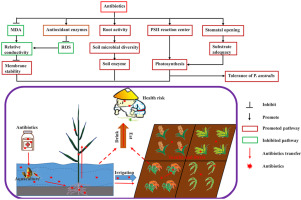当前位置:
X-MOL 学术
›
Chemosphere
›
论文详情
Our official English website, www.x-mol.net, welcomes your
feedback! (Note: you will need to create a separate account there.)
The tolerance mechanism and accumulation characteristics of Phragmites australis to sulfamethoxazole and ofloxacin.
Chemosphere ( IF 8.1 ) Pub Date : 2020-04-04 , DOI: 10.1016/j.chemosphere.2020.126695 Yao Lv 1 , Yanyan Li 2 , Xiaohui Liu 3 , Kun Xu 1
Chemosphere ( IF 8.1 ) Pub Date : 2020-04-04 , DOI: 10.1016/j.chemosphere.2020.126695 Yao Lv 1 , Yanyan Li 2 , Xiaohui Liu 3 , Kun Xu 1
Affiliation

|
Antibiotic pollution has become a hot issue worldwide, which has toxic effects on plants and even threatens human health. As a common wetland plant, the tolerance mechanism of Phragmites australis to antibiotics is rarely reported. In this study, we investigated the enrichment characteristics and biological response of P. australis to sulfamethoxazole (SMZ) and ofloxacin (OFL) residues, which are common in the environment. We found that the simulated concentration of antibiotics far exceeded the current level of antibiotic residues in the water environment, but it did not significantly inhibit the growth of P. australis. At 1 mg L-1, OFL and SMZ significantly increased the biomass of P. australis, which was mainly related to the improvement of root activity and photosynthetic efficiency, but the duplex treatment (SMZ + OFL) did not significantly stimulate the growth of reeds. OFL could significantly reduce the accumulation of reactive oxygen species (ROS) in P. australis. When OFL was 1 mg L-1, compared with control, superoxide anion and H2O2 were reduced by 11.19% and 10.76%, respectively, which was mainly related to the improvement of membrane stability. SMZ and SMZ + OFL had no significant effect on ROS, but they significantly increased antioxidant enzyme activity. SMZ and OFL could increase soil invertase, urease, and protease activities, and the tested antibiotics had no significant effect on the Shannon-Wiener index of soil microorganisms. The accumulation of antibiotics within tissues could be ranked as root > leaf > stem, and the accumulation and transport of OFL were higher than those of SMZ.
中文翻译:

芦苇对磺胺甲恶唑和氧氟沙星的耐受机制和积累特性。
抗生素污染已成为世界范围内的热点问题,对植物有毒作用,甚至威胁到人类健康。作为常见的湿地植物,很少报道芦苇对抗生素的耐受机制。在这项研究中,我们调查了P. australis对环境中常见的磺胺甲基异恶唑(SMZ)和氧氟沙星(OFL)残留物的富集特性和生物学响应。我们发现模拟的抗生素浓度远远超过了水环境中抗生素残留的当前水平,但是并没有显着抑制澳大利亚假单胞菌的生长。在1 mg L-1时,OFL和SMZ显着增加了澳大利亚假单胞菌的生物量,这主要与根系活性和光合效率的提高有关,但是双重处理(SMZ + OFL)并未显着刺激芦苇的生长。OFL可以显着减少澳大利亚假单胞菌中活性氧(ROS)的积累。当OFL为1 mg L-1时,与对照相比,超氧阴离子和H2O2分别减少11.19%和10.76%,这主要与膜稳定性的提高有关。SMZ和SMZ + OFL对ROS没有明显影响,但它们显着增加了抗氧化酶的活性。SMZ和OFL可以增加土壤转化酶,脲酶和蛋白酶的活性,测试的抗生素对土壤微生物的Shannon-Wiener指数没有显着影响。组织内抗生素的累积量可分为根>叶>茎,OFL的累积量和转运量均高于SMZ。
更新日期:2020-04-06
中文翻译:

芦苇对磺胺甲恶唑和氧氟沙星的耐受机制和积累特性。
抗生素污染已成为世界范围内的热点问题,对植物有毒作用,甚至威胁到人类健康。作为常见的湿地植物,很少报道芦苇对抗生素的耐受机制。在这项研究中,我们调查了P. australis对环境中常见的磺胺甲基异恶唑(SMZ)和氧氟沙星(OFL)残留物的富集特性和生物学响应。我们发现模拟的抗生素浓度远远超过了水环境中抗生素残留的当前水平,但是并没有显着抑制澳大利亚假单胞菌的生长。在1 mg L-1时,OFL和SMZ显着增加了澳大利亚假单胞菌的生物量,这主要与根系活性和光合效率的提高有关,但是双重处理(SMZ + OFL)并未显着刺激芦苇的生长。OFL可以显着减少澳大利亚假单胞菌中活性氧(ROS)的积累。当OFL为1 mg L-1时,与对照相比,超氧阴离子和H2O2分别减少11.19%和10.76%,这主要与膜稳定性的提高有关。SMZ和SMZ + OFL对ROS没有明显影响,但它们显着增加了抗氧化酶的活性。SMZ和OFL可以增加土壤转化酶,脲酶和蛋白酶的活性,测试的抗生素对土壤微生物的Shannon-Wiener指数没有显着影响。组织内抗生素的累积量可分为根>叶>茎,OFL的累积量和转运量均高于SMZ。











































 京公网安备 11010802027423号
京公网安备 11010802027423号